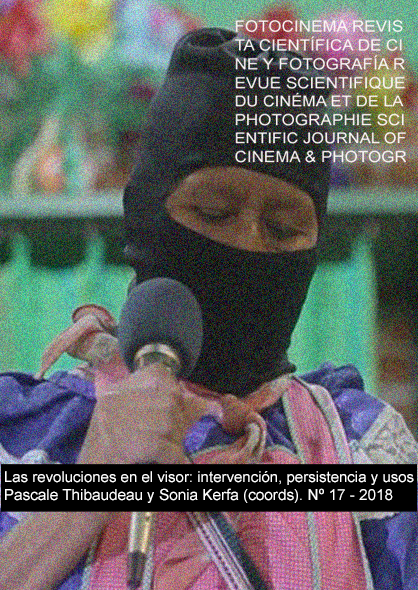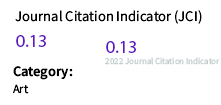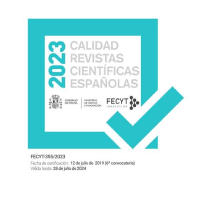Filmic form and otherness: towards an ethical reading of the Stanley Kubrick´s works
DOI:
https://doi.org/10.24310/Fotocinema.2018.v0i17.5119Keywords:
Stanley Kubrick, Filmic analyse, Audiovisual Narrative, Ethics, Filmic formAbstract
Our work tries to analyze the ethical implications of the filmic form in the movies directed by Stanley Kubrick. In order to achive our goal, we use a methodology of textual and narratological analyse over different movies –specially, Lolita, Spartacus and The Clockwork Orange-, trying to understand how the director uses the flows of empathy and the management of the “point of view” to rise complex debates about the nature of the world. The structure of our discussion is focused on his uses of the framing, the shot/reverse-shot filming, the edition and the structural disposition of his stories, looking for an ethical bet in his filmic writing. Finally, we conclude that against the common acussations of “pesismism” or even “nihilism”, Kubrick´s cinema is totally awar of the otherness and takes a decided care and rigour when it shows the complexity of the relations between human beings.
Downloads
Metrics
References
Baxter, J. (2005). Stanley Kubrick: Biografía. Madrid: T&B.
Bordwell, D. (1995). El Significado del filme: inferencia y retórica en la interpretación cinematográfica. Barcelona: Paidós.
Chion, M. (2002). Eyes Wide Shut. Londres: British Film Institute.
D. Hoffman, K. (2007). Allí donde termina el Arco Iris. Eyes Wide Shut. En: J. J. Abrahams (Ed.), La filosofía de Stanley Kubrick (pp. 79–112). Barcelona: Biblioteca Buridán.
Davis, N. Z. (2002). Trumbo and Kubrick argue History. Raritan Quarterly, 22(1), 173–181.
Deleuze, G. (1984). La imagen-movimiento. Estudios sobre cine 1. Barcelona: Paidós.
F. Cooke, E. (2007). Entender al enemigo: El diálogo del miedo entre Fear and Desire y en Dr. Strangelove. En: J. J. Abrams (Ed.), La filosofía de Stanley Kubrick (pp. 17–46). Barcelona: Biblioteca Buridán.
F. Wheat, L. (2000). Kubrick´s 2001: A triple allegory. Kent: Scarecrow Press.
Falsetto, M. (2001). Stanley Kubrick: A narrative and Stylistic Analysis. Westport: Praeger.
Feldmann, H. (1976). Kubrick and his discontents. Film Quarterly, 30(1), 12–19.
Finol, L. (2016). Stanley Kubrick y la espiral del tiempo. Fotocinema: Revista Científica de Cine Y Fotografía, 12, 239–262.
Freixas, R., & Bassa, J. (2017). Futuros imperfectos. A propósito de “La naranja mecánica” y “Rollerball.” En: A. J. Navarro (Ed.), Distopía y cine. Futuro(s) imperfecto(s) (pp. 171–178). San Sebastián: Donostia Kultura - Filmoteca Vasca.
Gómez Tarín, F. J. (2011). Elementos de narrativa audiovisual: expresión y narración. Santander: Shangrila.
González Requena, J. (1992). S. M. Eisenstein: lo que solicita ser escrito. Madrid: Cátedra.
Herr, M. (2006). Kubrick. Barcelona: Anagrama.
Kagan, N. (1976). Stanley Kubrick. Barcelona: Lumen.
Kolker, R. (2011). A Cinema of Loneliness. Oxford: Oxford University Press.
Lacan, J. (2011). El seminario 7. La Ética del psicoanálisis. Buenos Aires: Paidós.
Lévinas, E. (2000). De la existencia al existente. Madrid: Arena Libros.
Lévinas, E. (2003). De otro modo que ser o más allá de la esencia. Salamanca: Sígueme.
Lévinas, E. (2006). Los imprevistos de la Historia. Salamanca: Sígueme.
M. Winkler, M. (2007). Spartacus: Film and History. Malden: Blackwell Publishing.
Marzal Felici, J. J., & Rubio Marco, S. (1999). Guía para ver y analizar: “La naranja mecánica.” Valencia: Nau Llibres.
Nelson, T. A. (2000). Kubrick: inside a film artist’s maze. Bloomington: Indiana University Press.
Palao Errando, J. A. (2004). La Profecía de la imagen-mundo: para una genealogía del paradigma informativo. Valencia: Ediciones de la Filmoteca. Instituto Valenciano de Cinematografia Ricardo Muñoz Suay.
Pascal, B. (2012). Pensamientos. Madrid: Gredos.
Rimbau, E. (1990). Stanley Kubrick. Madrid: Cátedra.
Roaro, J. (2015). Nietzsche y la transformación del espíritu del hombre. Disputatio. Philosophical Research Bulletin, 4(5), 51–66.
Rodríguez Serrano, A. (2015). Arquitecturas de la angustia: un diálogo entre Martin Heidegger y Stanley Kubrick. Trama & Fondo: Revista de Cultura, 38, 83–94.
Shaw, D. (2005). Kubrick Contra Nihilism: A Clockwork Orange. Film and Philosophy, 9.
Sperb, J. (2006). The Kubrick Facade: Faces and voices in the films of Stanley Kubrick. Maryland: Scarecrow Press.
Walter Bruno, M., & Lupo, L. (2004). Nietzsche en Kubrick: un análisis sobre cine y filosofía. Paideia, 25(68), 217–238.
Zepke, S. (2007). Against Nihilism: Nietzsche and Kubrick on the Future of Man. Journal of French and Francophone Philosophy, 17(2), 37–69.
Zumalde, I. (2006). La Materialidad de la forma fílmica: crítica de la (sin)razón postestructuralista. Bilbao: Euskal Herriko Unibertsitatea. Argitalpen Zerbitzua.
Zumalde, I. (2011). La Experiencia fílmica: cine, pensamiento y emoción. Madrid: Cátedra.
Downloads
Additional Files
Published
How to Cite
Issue
Section
License
All contents published in Fotocinema Revista científica de cine y fotografía are protected under the Creative Commons Attribution-NonCommercial-ShareAlike 4.0 International (CC BY-NC-SA 4.0) license. All about this license is available in the following link: <http://creativecommons.org/licenses/by-nc-sa/4.0>
Users can copy, use, redistribute, share and exhibit publicly as long as:
- The original source and authorship of the material are cited (Journal, Publisher and URL of the work).
- It is not used for comercial purposes.
- The existence of the license and its especifications are mentioned.
There are two sets of authors’ rights: moral and property rights. Moral rights are perpetual prerogatives, unrenounceable, not-transferable, unalienable, imprescriptible and inembargable. According to authors’ rights legislation, Fotocinema. Revista científica de cine y fotografía recognizes and respects authors moral rights, as well as the ownership of property rights, which will be transferred to University of Malaga in open access. The property rights are referred to the benefits that are gained by the use or the dissemination of works. Fotocinema. Revista científica de cine y fotografía is published in an open access form and it is exclusively licenced by any means for doing or authorising distribution, dissemination, reproduction, , adaptation, translation or arrangement of works.
Authors are responsable for obtaining the necessary permission to use copyrighted images.










.png)

13.png)




